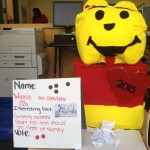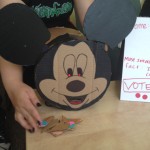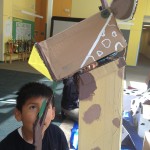 Tanya Kryukova—our twelfth grade physics teacher—helped our seniors squeeze a final making project into the last two weeks of school—and they really came through with it! They built a robot petting zoo, and invited the lower-level classes to come say hello to their animals. It was a great end to a great school year.
Tanya Kryukova—our twelfth grade physics teacher—helped our seniors squeeze a final making project into the last two weeks of school—and they really came through with it! They built a robot petting zoo, and invited the lower-level classes to come say hello to their animals. It was a great end to a great school year.
This project comes from the Lawrence Hall of Science TechHive, and we’d like to give them our sincere thanks for not only developing and introducing us to this project, but for also volunteering their time to help our students with their robots. A special thanks to: A.J. Almagner, Andrew Milne, and Matt Chilbert for coming to Lighthouse to work with our team.
So! This is a robot petting zoo:
(Video courtesy of members of the Lawrence Hall of Science TechHive.)
These animals (and pop sensations) were built from cardboard, and use Hummingbird Robotics Kits that are programmed using Scratch. Each animal has sensors (mostly motion, but some use sound), that allow the robots to react to a stimulus. In the video above, when you see students feeding the animals, they are actually triggering motion sensors, which then causes the animals to wiggle their ears, or shout “Yum!” etc.
As an introduction to this project, each of our students worked on the same animal—a pig—for a day, learning how to program it to wiggle its ears. Then they began working on their individual animals. I took some time to talk with a few of the different groups:
Q: Why did you choose to build a Squirtle? (For those of you who don’t know, Squirtle is a type of Pokemon.)
A: Half of our group wanted to build a squirrel, and the other half a turtle. We just decided to combine them.
Q: If you were to do this project again, what would you do differently?
A: We would probably make his shape more cube-like. Trying to use cardboard to make cylindrical and spherical shapes was really hard.
Q: What was the hardest part of this project?
A: The design. Figuring out how to bend the cardboard into the right shape.
Q: Are you aware that Beyoncé is not an animal?
A: She’s my spirit animal.
Q: What was the hardest part of this project?
A: Getting the sensors to work correctly. Somehow we kept messing up when trying to get the hand to wave and the music to play at the same time.
Q: What was the most fun part of this project?
A: Having the kids try it! Seeing their reactions. Some of them were dancing and singing.
Group: Owl
Q: If you were to do this project again, what would you do differently?
A: Find a better way to attach the wings. They keep falling off.
Q: What was the hardest part of the project?
A: Knowing how to construct the wings, in order to make them move. Also, the shape of the body and head. At first we thought we were designing our project wrong because we did it differently from all of the other groups.
Q: How so?
A: The other groups drew stencils of their animals first that they kinda built around. We just started stacking boxes of cardboard, like a snowman. But as we went further into the project, we realized that it’s okay to have different creative ideas about how to build our robots.
I think that last answer was my favorite of the day—and probably of the year.
“It’s okay to have different creative ideas.” –Lighthouse Student.
I’m going to end with that (save for a few pictures).
We have a summer making program starting next week, so I will still be adding regular posts to keep you all up to date on our program, but other than that: Have a great summer everyone!
![]()
About
David is the documentarian and professional development coordinator for the Creativity Lab. In 2014, he received a BA in creative writing from Louisiana State University, with focuses on short fiction and screenwriting. In partnering with New Orleans-based independent film company, Asymptote Pictures, his work has been featured in film festivals across the country. He likes his espresso maker, and vegetarian tacos.










